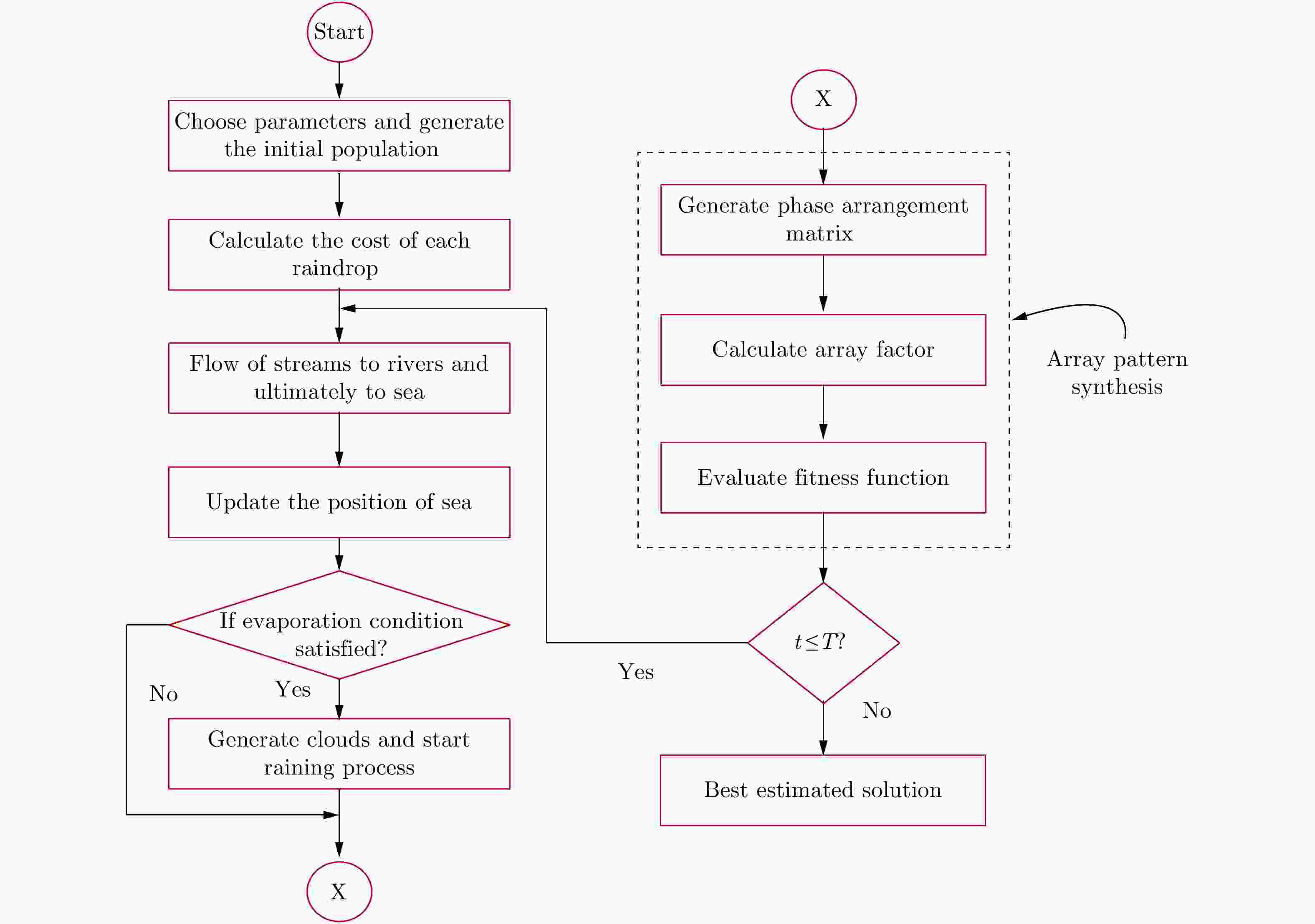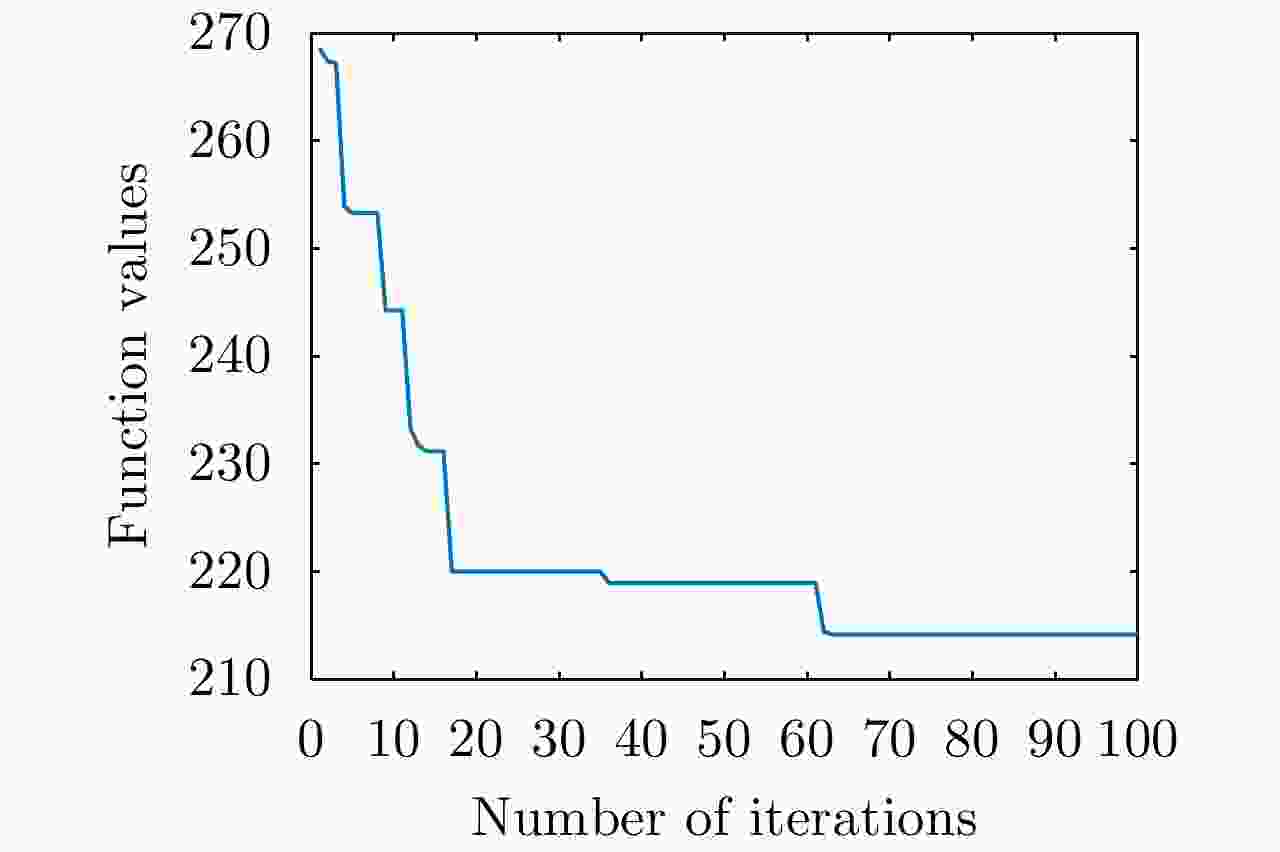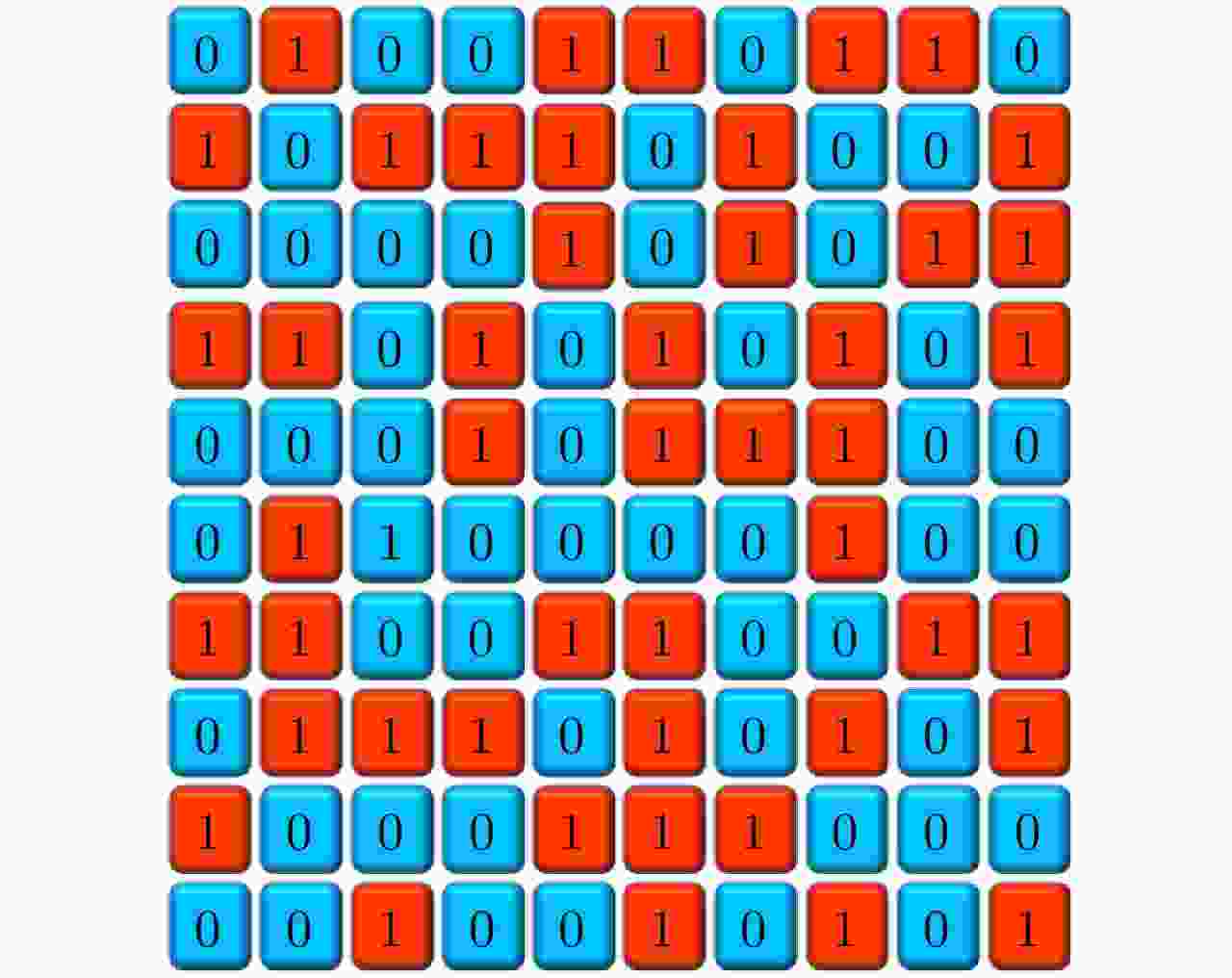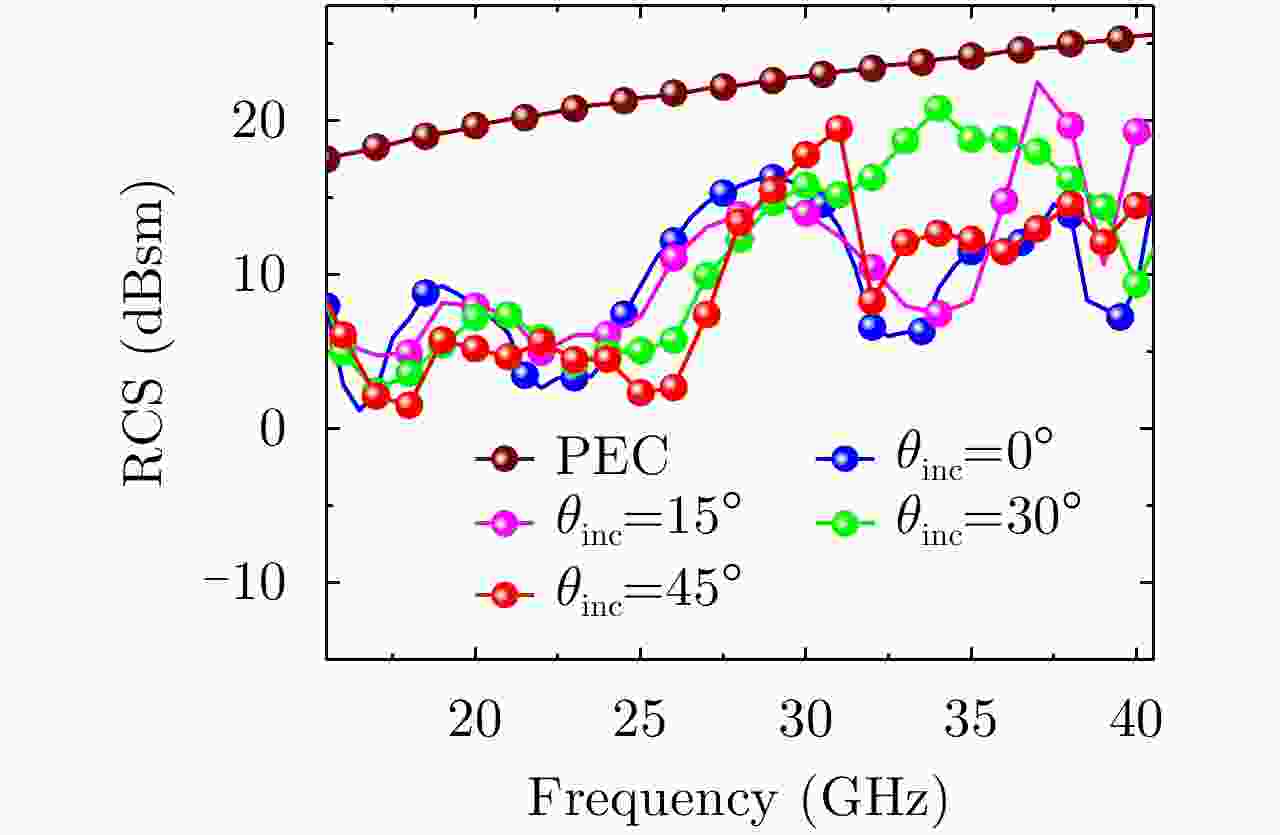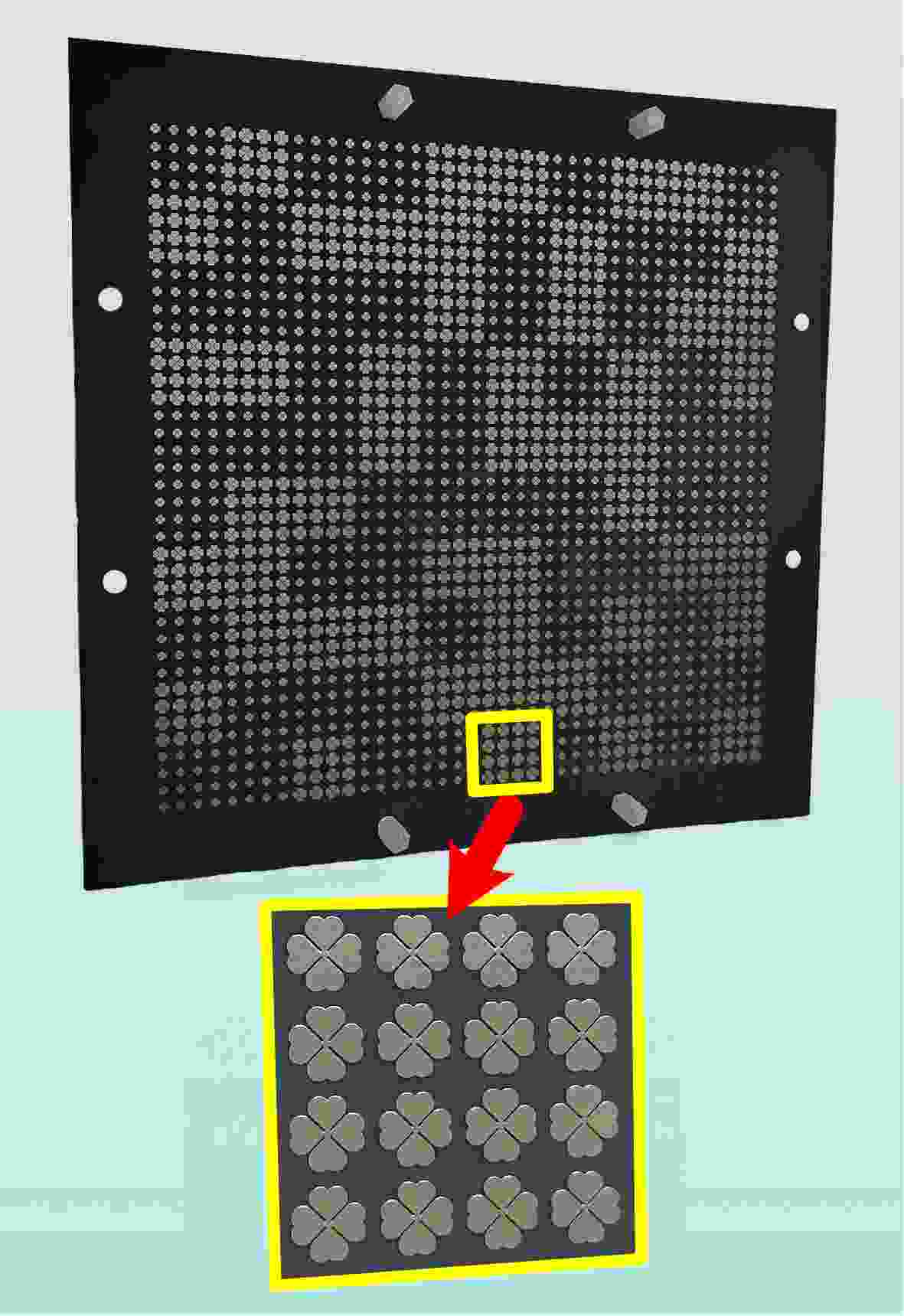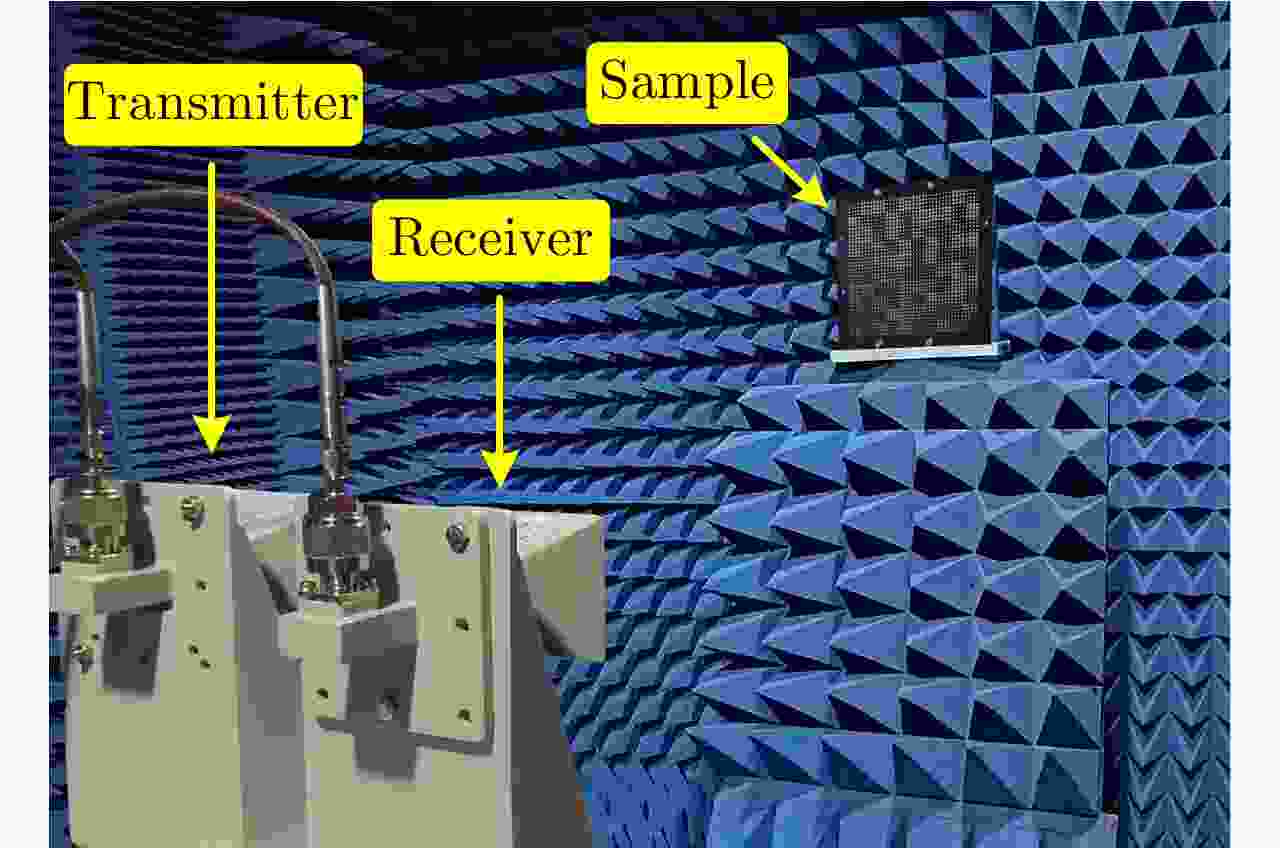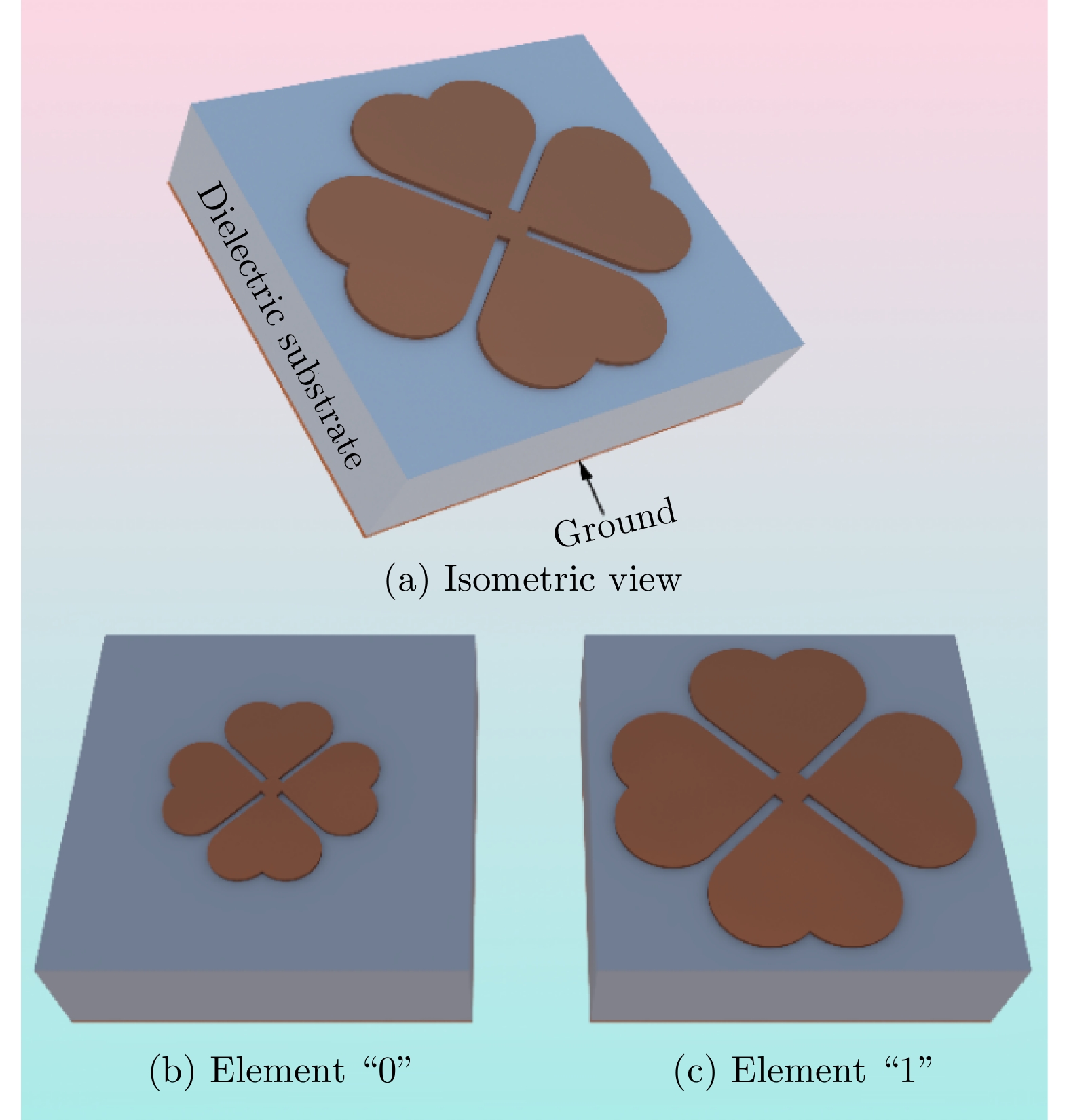A Four-leaf Clover-shaped Coding Metasurface For Ultra-wideband Diffusion-like Scattering
DOI: 10.12000/JR21061 cstr: 32380.14.JR21061
-
摘要: 该文提出了一种结构新颖的四叶草形编码超表面,并利用该超表面实现了超宽带漫散射。所提出的编码超表面具有旋转对称性,它对x极化和y极化波产生相似的反射特性。为了实现1比特编码超表面,该文设计了在15.5~40.5 GHz的频率范围内且相位差为180°±37°的两个超表面单元。采用优化算法得到阵列中单元的最佳排列,从而实现了宽带RCS的缩减。四叶草形编码超表面可以在15.5~26.5 GHz和30.5~40.5 GHz这两个频带内实现10 dB的RCS缩减。该文加工了该编码超表面并与仿真结果进行了比较,从而有效验证了所设计的四叶草形编码超表面可以在宽频带内实现RCS的缩减。Abstract: In this paper, a novel four-leaf clover-shaped coding metasurface is proposed and applied to achieve an ultra-wideband diffusion-like scattering. The proposed metasurface element has rotational symmetry; hence, it produces similar reflection characteristics for both x- and y-polarized waves. To realize a 1-bit coding metasurface, two elements are chosen that have a phase difference of 180°±37° from 15.5 to 40.5 GHz. An optimization algorithm is applied to get the best arrangement of unit cells in the array to attain the wideband RCS reduction. The four-leaf clover-shaped metasurface can attain more than 10 dB RCS reduction from 15.5 to 26.5 GHz and 30.5 to 40.5 GHz. A prototype of the proposed design is fabricated, and an experiment is carried out to validate the performance of the metasurface. The proposed concept of four-leaf clover-shaped coding metasurface is an effective solution for wideband RCS reduction applications.
-
Table 1. Comparison of our work with earlier works
Ref. Freq. band (GHz) σR (dB) Metasurface arrangement Thickness FBW (%) [22] 11.60~18.65 10 Random 0.15λ0 46 [23] 9.9~19.8 10 Random 0.15λ0 66 [24] 8~18 10 Random 0.13λ0 77 [25] 7.2~15.6 10 Random 0.12λ0 73 [26] 12.2~23.4 10 Spiral coding 0.12λ0 62 [27] 5.57~7.37 10 Ergodic 0.06λ0 28 [28] 5.8~12.2 10 GA 0.14λ0 77 [29] 6.94~9.23 10 GA 0.05λ0 28 [20] 12~24 10 GA 0.12λ0 66 [30] 8~15 10 Random 0.10λ0 0.47 This work 15.5~26.5, 30.5~40.5 10 WCA 0.13λ0 80 λ0 is the free-space wavelength corresponding to the center frequency of the operation bandwidth.
FBW: The fractional bandwidth FBW= (fH – fL)/fc, fc = (fH + fL) /2
σR: RCS reduction -
[1] MA Qian, BAI Guodong, JING Hongbo, et al. Smart metasurface with self-adaptively reprogrammable functions[J]. Light: Science & Applications, 2019, 8: 98. doi: 10.1038/s41377-019-0205-3 [2] ARBABI A, HORIE Y, BAGHERI M, et al. Dielectric metasurfaces for complete control of phase and polarization with subwavelength spatial resolution and high transmission[J]. Nature Nanotechnology, 2015, 10(11): 937–943. doi: 10.1038/nnano.2015.186 [3] SCHURIG D, MOCK J J, JUSTICE B, et al. Metamaterial electromagnetic cloak at microwave frequencies[J]. Science, 2006, 314(5801): 977–980. doi: 10.1126/science.1133628 [4] ZHENG Guoxing, MÜHLENBERND H, KENNEY M, et al. Metasurface holograms reaching 80% efficiency[J]. Nature Nanotechnology, 2015, 10(4): 308–312. doi: 10.1038/nnano.2015.2 [5] LI Yong and ASSOUAR B M. Acoustic metasurface-based perfect absorber with deep subwavelength thickness[J]. Applied Physics Letters, 2016, 108(6): 063502. doi: 10.1063/1.4941338 [6] CUI Tiejun, QI Mengqing, WAN Xiang, et al. Coding metamaterials, digital metamaterials and programmable metamaterials[J]. Light: Science & Applications, 2014, 3(10): e218. doi: 10.1038/lsa.2014.99 [7] ZHENG Yuejun, GAO Jun, CAO Xiangyu, et al. Wideband RCS reduction of a microstrip antenna using artificial magnetic conductor structures[J]. IEEE Antennas and Wireless Propagation Letters, 2015, 14: 1582–1585. doi: 10.1109/LAWP.2015.2413456 [8] PAQUAY M, IRIARTE J C, EDERRA I, et al. Thin AMC structure for radar cross-section reduction[J]. IEEE Transactions on Antennas and Propagation, 2007, 55(12): 3630–3638. doi: 10.1109/TAP.2007.910306 [9] GALARREGUI J C I, PEREDA A T, DE FALCÓN J L M, et al. Broadband radar cross-section reduction using amc technology[J]. IEEE Transactions on Antennas and Propagation, 2013, 61(12): 6136–6143. doi: 10.1109/TAP.2013.2282915 [10] JIA Yongtao, LIU Ying, GUO Y J, et al. Broadband polarization rotation reflective surfaces and their applications to RCS reduction[J]. IEEE Transactions on Antennas and Propagation, 2016, 64(1): 179–188. doi: 10.1109/TAP.2015.2502981 [11] WANG He, HUANG Jiyao, WANG Honglin, et al. Chaos-based coding metasurface for radar cross-section reduction[J]. Journal of Physics D: Applied Physics, 2019, 52(40): 405304. doi: 10.1088/1361-6463/ab2dc6 [12] CHEN Jie, CHENG Qiang, ZHAO Jie, et al. Reduction of radar cross section based on a metasurface[J]. Progress in Electromagnetics Research, 2014, 146: 71–76. doi: 10.2528/PIER14022606 [13] SUI Sai, MA Hua, WANG Jiafu, et al. Absorptive coding metasurface for further radar cross section reduction[J]. Journal of Physics D: Applied Physics, 2018, 51(6): 065603. doi: 10.1088/1361-6463/aaa3be [14] LI Sijia, CAO Xiangyu, XU Liming, et al. Ultra-broadband reflective metamaterial with rcs reduction based on polarization convertor, information entropy theory and genetic optimization algorithm[J]. Scientific Reports, 2016, 6: 37409. doi: 10.1038/srep37409 [15] LI Haipeng, WANG Guangming, CAI Tong, et al. Wideband transparent beam-forming metadevice with amplitude- and phase-controlled metasurface[J]. Physical Review Applied, 2019, 11(1): 014043. doi: 10.1103/PhysRevApplied.11.014043 [16] SUN Hengyi, GU Changqing, CHEN Xinlei, et al. Broadband and broad-angle polarization-independent metasurface for radar cross section reduction[J]. Scientific Reports, 2017, 7: 40782. doi: 10.1038/srep40782 [17] SU Jianxun, LU Yao, LIU Jiayi, et al. A novel checkerboard metasurface based on optimized multielement phase cancellation for superwideband RCS reduction[J]. IEEE Transactions on Antennas and Propagation, 2018, 66(12): 7091–7099. doi: 10.1109/TAP.2018.2870372 [18] YANG Jianing, HUANG Cheng, SONG Jiakun, et al. Ultra-broadband low scattering metasurface utilizing mixed-elements based on phase cancellation[J]. Journal of Physics D: Applied Physics, 2020, 53(2): 025102. doi: 10.1088/1361-6463/ab4b2e [19] HAJI-AHMADI M J, NAYYERI V, SOLEIMANI M, et al. Pixelated checkerboard metasurface for ultra-wideband radar cross section reduction[J]. Scientific Reports, 2017, 7(1): 11437. doi: 10.1038/s41598-017-11714-y [20] SUI Sai, MA Hua, LV Yueguang, et al. Fast optimization method of designing a wideband metasurface without using the Pancharatnam–Berry phase[J]. Optics Express, 2018, 26(2): 1443–1451. doi: 10.1364/OE.26.001443 [21] ESKANDAR H, SADOLLAH A, BAHREININEJAD A, et al. Water cycle algorithm–a novel metaheuristic optimization method for solving constrained engineering optimization problems[J]. Computers & Structures, 2012, 110/111: 151–166. doi: 10.1016/j.compstruc.2012.07.010 [22] FENG Maochang, LI Yongfeng, ZHENG Qiqi, et al. Two-dimensional coding phase gradient metasurface for rcs reduction[J]. Journal of Physics D: Applied Physics, 2018, 51(37): 375103. doi: 10.1088/1361-6463/aad5ad [23] ZHENG Qiqi, LI Yongfeng, ZHANG Jieqiu, et al. Wideband, wide-angle coding phase gradient metasurfaces based on pancharatnam-berry phase[J]. Scientific Reports, 2017, 7: 43543. doi: 10.1038/srep43543 [24] SU Pei, ZHAO Yongjiu, JIA Shengli, et al. An ultra-wideband and polarization-independent metasurface for RCS reduction[J]. Scientific Reports, 2016, 6: 20387. doi: 10.1038/srep20387 [25] ZHUANG Yaqiang, WANG Guangming, LIANG Jiangang, et al. Random combinatorial gradient metasurface for broadband, wide-angle and polarization-independent diffusion scattering[J]. Scientific Reports, 2017, 7(1): 16560. doi: 10.1038/s41598-017-16910-4 [26] YUAN Fang, WANG Guangming, XU Hexiu, et al. Broadband RCS reduction based on spiral-coded metasurface[J]. IEEE Antennas and Wireless Propagation Letters, 2017, 16: 3188–3191. doi: 10.1109/LAWP.2017.2768129 [27] LIU Xiao, GAO Jun, XU Liming, et al. A coding diffuse metasurface for RCS reduction[J]. IEEE Antennas and Wireless Propagation Letters, 2016, 16: 724–727. doi: 10.1109/LAWP.2016.2601108 [28] SU Jianxun, HE Huan, LI Zengrui, et al. Uneven-layered coding metamaterial tile for ultra-wideband RCS reduction and diffuse scattering[J]. Scientific Reports, 2018, 8(1): 8182. doi: 10.1038/s41598-018-26386-5 [29] HAN Xinmin, XU Haojun, CHANG Yipeng, et al. Multiple diffuse coding metasurface of independent polarization for RCS reduction[J]. IEEE Access, 2020, 8: 162313–162321. doi: 10.1109/ACCESS.2020.3021650 [30] CHEN Ke, CUI Li, FENG Yijun, et al. Coding metasurface for broadband microwave scattering reduction with optical transparency[J]. Optics Express, 2017, 25(5): 5571–5579. doi: 10.1364/OE.25.005571 -



 作者中心
作者中心 专家审稿
专家审稿 责编办公
责编办公 编辑办公
编辑办公
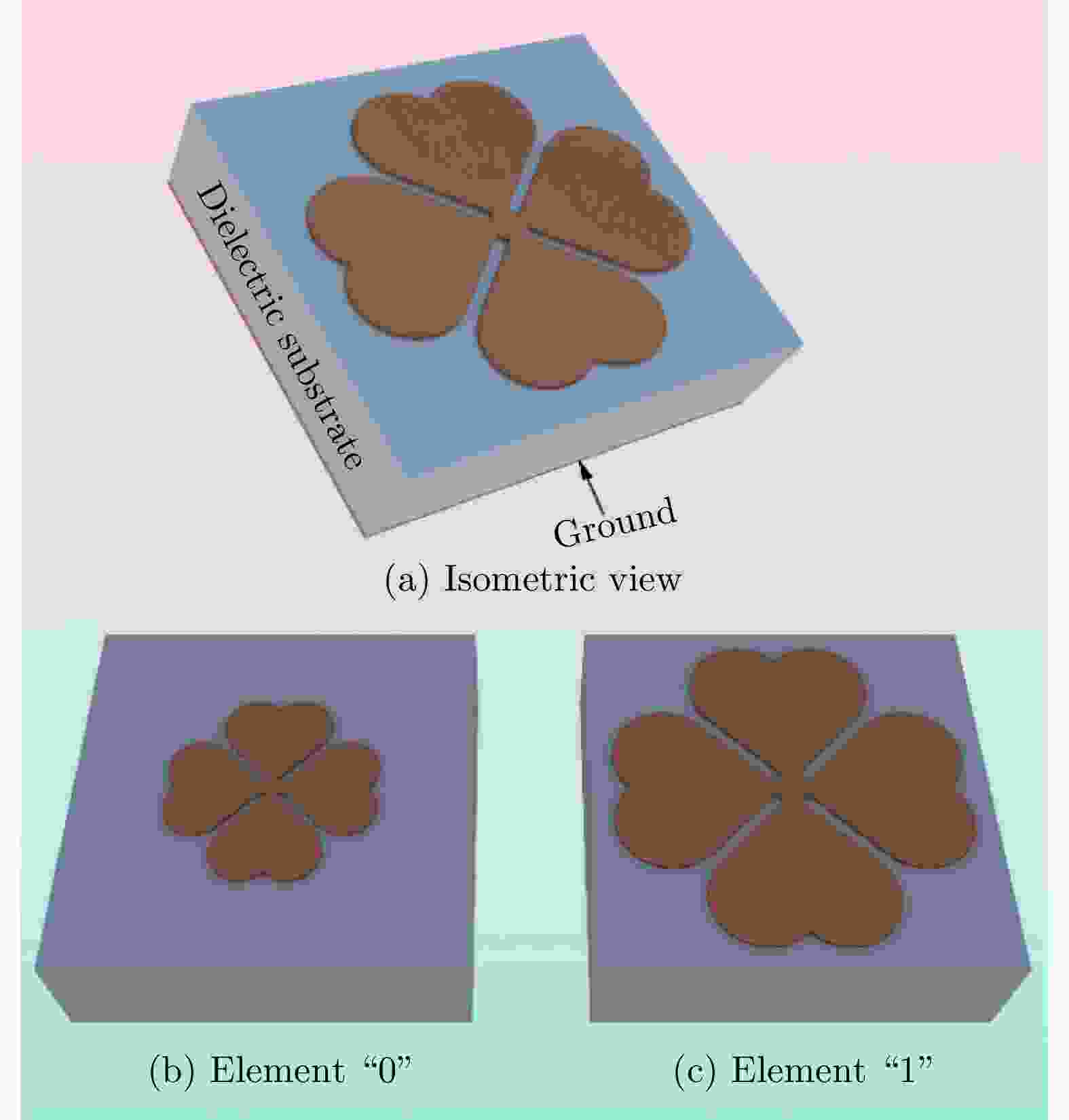
 下载:
下载:

